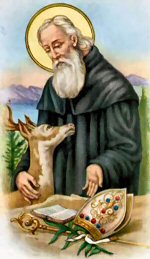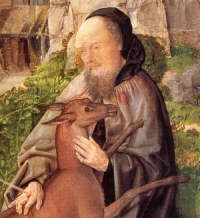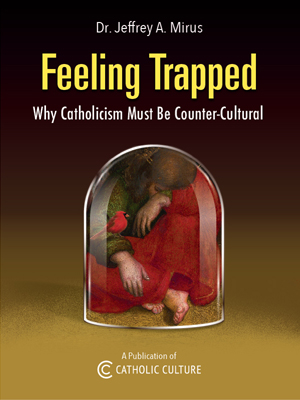Ordinary Time: September 1st
Monday of the Twenty-Second Week of Ordinary Time
Other Commemorations: St. Giles, Hermit and Abbot (RM)
» Enjoy our Liturgical Seasons series of e-books!
In the General Roman Calendar, this date is a "feria" or "ferial day", or a weekday in Ordinary Time. No feast of a saint is celebrated. Ordinary in this instance does not mean "common" or "mundane", but refers to counted time, coming from the word "ordinal". The readings and prayers of the Mass during this season retell the story of our salvation history through Jesus Christ.
Before the reform of the Roman Calendar in 1969, this was the memorial of St. Giles, Abbot. His feast has been transferred to particular calendars. If St. Giles is the patron, local churches, monasteries, dioceses may still celebrate this saint's feast. And of course, those named after this saint would celebrate their nameday on this date. During the Middle Ages, especially during the time of the Black Plague (1346-1349), there was a large devotion to St. Giles. He is part of the Fourteen Holy Helpers.
St. Giles
 According to tradition, St. Giles was born in Athens, Greece, and was of noble extraction. After his parents died, he fled from his fatherland to avoid followers and fame. He went to France, and in a cave in a forest near the mouth of the Rhone he was able to lead the life of a hermit. Legend notes a hind came everyday to his cell and furnished him with milk. One day the King's hunters chased the hind and discovered St. Giles and his secret hermitage. The hunters shot at the hind, but missed and hit Giles' leg with an arrow, which kept him crippled the rest of his life. He then consented to King Theodoric's request of building a monastery (known later as "Saint Gilles du Gard") and he became its first Abbot. He died some eight years later towards 712.
According to tradition, St. Giles was born in Athens, Greece, and was of noble extraction. After his parents died, he fled from his fatherland to avoid followers and fame. He went to France, and in a cave in a forest near the mouth of the Rhone he was able to lead the life of a hermit. Legend notes a hind came everyday to his cell and furnished him with milk. One day the King's hunters chased the hind and discovered St. Giles and his secret hermitage. The hunters shot at the hind, but missed and hit Giles' leg with an arrow, which kept him crippled the rest of his life. He then consented to King Theodoric's request of building a monastery (known later as "Saint Gilles du Gard") and he became its first Abbot. He died some eight years later towards 712.
In Normandy, France, women having difficulty becoming pregnant would sleep with a picture or statue of the saint.
In England, churches named for St. Giles were built so that cripples could reach them easily. St. Giles was also considered the chief patron of the poor. In his name charity was granted the most miserable. This is evidenced from the custom that on their passage to Tyburn for execution, convicts were allowed to stop at St. Giles' Hospital where they were presented with a bowl of ale called St. Giles' Bowl, "thereof to drink at their pleasure, as their last refreshment in this life."
St. Giles is included in the list of the fourteen "Auxiliary Saints" or "Holy Helpers." These are a group of saints invoked because they have been efficacious in assisting in trials and sufferings. Each saint has a separate feast or memorial day. The group was collectively venerated on August 8, until the 1969 reform of the Roman calendar, when the feast was dropped.
Patronage: abandoned; Beggars; blacksmiths; breast cancer, breastfeeding; cancer patients; crippled people; disabled; epilepsy; fear of night/noctiphobia; forests; handicapped; hermits; horses; insanity; lepers; leprosy; mental illness; paupers; physically disabled; rams; spur makers; woods; against lameness; against leprosy; against sterility; against infertility
Symbols and Representation: arrow, cave, crosier, deer, hind, doe, roe, hermitage
Often represented as:Hand pierced with arrows; hind pierced with arrows; gold doe, pierced by a silver arrow; Benedictine with crosier, arrow piercing hand, protecting hind, Benedictine monk accompanied by a hind, lilies growing in the sand
Highlights and Things to Do:
- Pray to St. Giles for the conversion of England and Scotland.
- Learn more about St. Giles:
- Visit Christian Iconography for images and symbols of St. Giles.
- Visit this site to learn more about the influence St. Giles had in England. Keep in mind that the church was a Catholic Church before Henry the VIII confiscated all the Church's property. This site shows how the reformation affected St. Giles Cathedral in Scotland.
- Read The Golden Legend of St. Giles.
- For children, read In God's Garden—St. Giles by Amy Steedman.
- St. Giles is one of the Fourteen Holy Helpers. Read Legends of the Fourteen Holy Helpers – Saint Giles, Hermit and Abbot. He was invoked against plague, epilepsy, mental illness, and nightmares, for a good confession, and patron of cripples, beggars, blacksmiths, and breast-feeding mothers.






